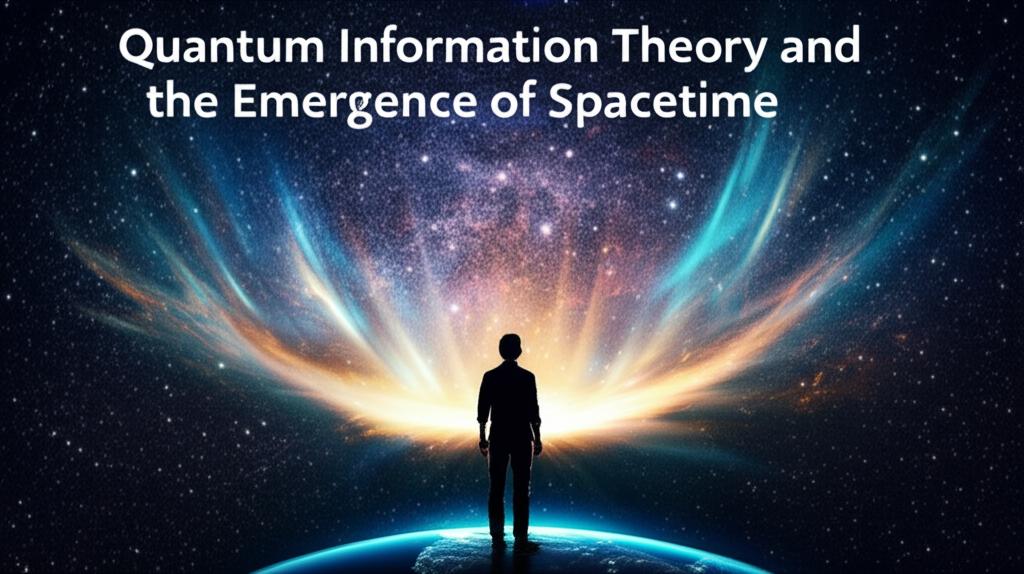The relationship between quantum information theory and the emergence of spacetime is a rapidly developing area of theoretical physics, aiming to bridge the gap between quantum mechanics and general relativity. Here's a summary of recent insights and ongoing research:
Core Idea: Spacetime is Not Fundamental, It EmergesThe central hypothesis is that spacetime, as we perceive it, is not a fundamental entity but rather an emergent phenomenon. This means it arises from the interactions and entanglement of more basic, underlying quantum constituents. Think of it like the way the fluidity of water emerges from the collective behavior of individual H2O molecules; the "fluidity" isn't a property of a single molecule. In this context, the structure and geometry of spacetime are thought to emerge from the entanglement patterns of a quantum state, potentially in a lower-dimensional, non-spatial theory.
Key Concepts and Supporting Evidence:- Quantum Entanglement as the "Glue": A crucial idea is that quantum entanglement – the "spooky action at a distance" that links particles regardless of their separation – plays a fundamental role in "stitching together" the fabric of spacetime. The more entangled different quantum systems or regions are, the closer they are in the emergent spacetime geometry. This concept suggests that entanglement generates the very dimensions of gravitational theory.
- Holographic Principle and AdS/CFT Correspondence: These well-established concepts in theoretical physics provide strong motivation.
The holographic principle suggests that the information contained within a volume of space can be described by a theory on its boundary. This implies our 3D universe might be a holographic projection of physics occurring on a 2D surface.
The AdS/CFT correspondence (Anti-de Sitter/Conformal Field Theory) is a concrete example of this, showing a duality between a gravitational theory in a higher-dimensional (AdS) spacetime and a quantum field theory without gravity in a lower dimension (CFT). This correspondence has revealed deep connections between entanglement in the CFT and geometry in the AdS space. For instance, the Ryu-Takayanagi formula directly relates entanglement entropy in the boundary theory to the area of minimal surfaces in the bulk spacetime.
- Quantum Error Correction: This set of techniques, initially developed for protecting information in quantum computers from noise and decoherence, has surprisingly found a crucial role in understanding emergent spacetime. The idea is that spacetime itself behaves like a quantum error-correcting code. This means that local information in the "bulk" (the emergent spacetime) is encoded redundantly in the "boundary" (the underlying quantum system). This redundancy explains the robustness of spacetime and how coherent quantum information can be preserved, allowing a classical-like spacetime to emerge from quantum degrees of freedom.
- ER=EPR Conjecture: This conjecture proposes a deep connection between quantum entanglement (EPR, named after Einstein, Podolsky, and Rosen) and wormholes (ER, or Einstein-Rosen bridges). It suggests that entangled particles are connected by microscopic wormholes, providing another link between quantum correlations and spacetime structure.
- Entanglement Entropy and Geometry: Entanglement entropy, which quantifies the amount of entanglement between different parts of a quantum system, acts as a bridge between quantum information and geometry. Increases in entanglement can correspond to increases in the proximity of regions in the emergent spacetime.
- Informational Stress-Energy Tensor: Some recent theories propose incorporating an "informational stress-energy tensor" into Einstein's field equations. This tensor would be derived from quantum entanglement entropy, suggesting that the curvature of spacetime (gravity) is not just a response to mass and energy, but also to the information structure of quantum fields.
- Resolving Fundamental Puzzles: This line of research offers potential resolutions to long-standing problems in physics, such as the black hole information paradox (what happens to information that falls into a black hole) and the unification of quantum mechanics and general relativity into a theory of quantum gravity.
- New Understanding of Gravity: If gravity emerges from quantum information, it fundamentally reframes our understanding of this fundamental force. It could be seen as an entropic force or a consequence of the statistical behavior of underlying quantum information.
- Connections to Quantum Computing: The unexpected link to quantum error correction suggests that the principles governing the stability of spacetime might be deeply related to those needed to build fault-tolerant quantum computers. Advances in one field could inform the other.
- Experimental Probes (Challenges): While many of these ideas are highly theoretical, researchers are exploring potential, albeit extremely challenging, ways to test them. These could involve looking for:
Modifications to particle dispersion relations at very high energies.
Deviations from Lorentz invariance.
Quantum gravitational effects imprinted on the cosmic microwave background.
Quantum corrections in gravitational wave observations.
- Ongoing Research and Open Questions:
While the AdS/CFT correspondence provides a powerful theoretical laboratory, our universe is not an Anti-de Sitter space (it's closer to a de Sitter space, due to accelerating expansion). Extending these ideas to more realistic cosmological spacetimes is a major challenge.
Clarifying the precise mechanisms by which macroscopic, classical spacetime emerges from discrete quantum information remains an active area of investigation.
* Developing a complete and consistent mathematical framework that fully derives Einstein's equations (or a modification of them) from quantum information principles is a primary goal.
In essence, the exploration of quantum information theory's role in the emergence of spacetime represents a paradigm shift, suggesting that information, particularly quantum entanglement, might be more fundamental than space and time themselves. This research frontier is pushing the boundaries of our understanding of reality, connecting disparate fields of physics in surprising and profound ways.

